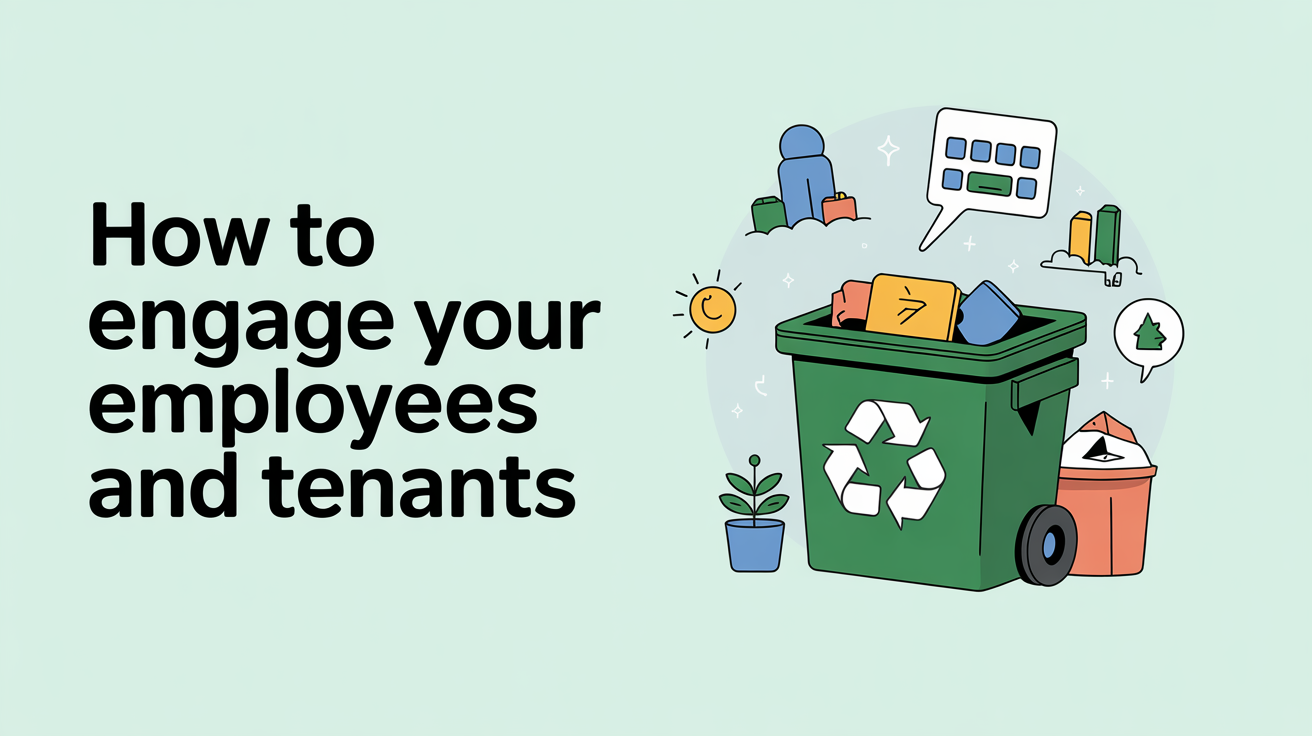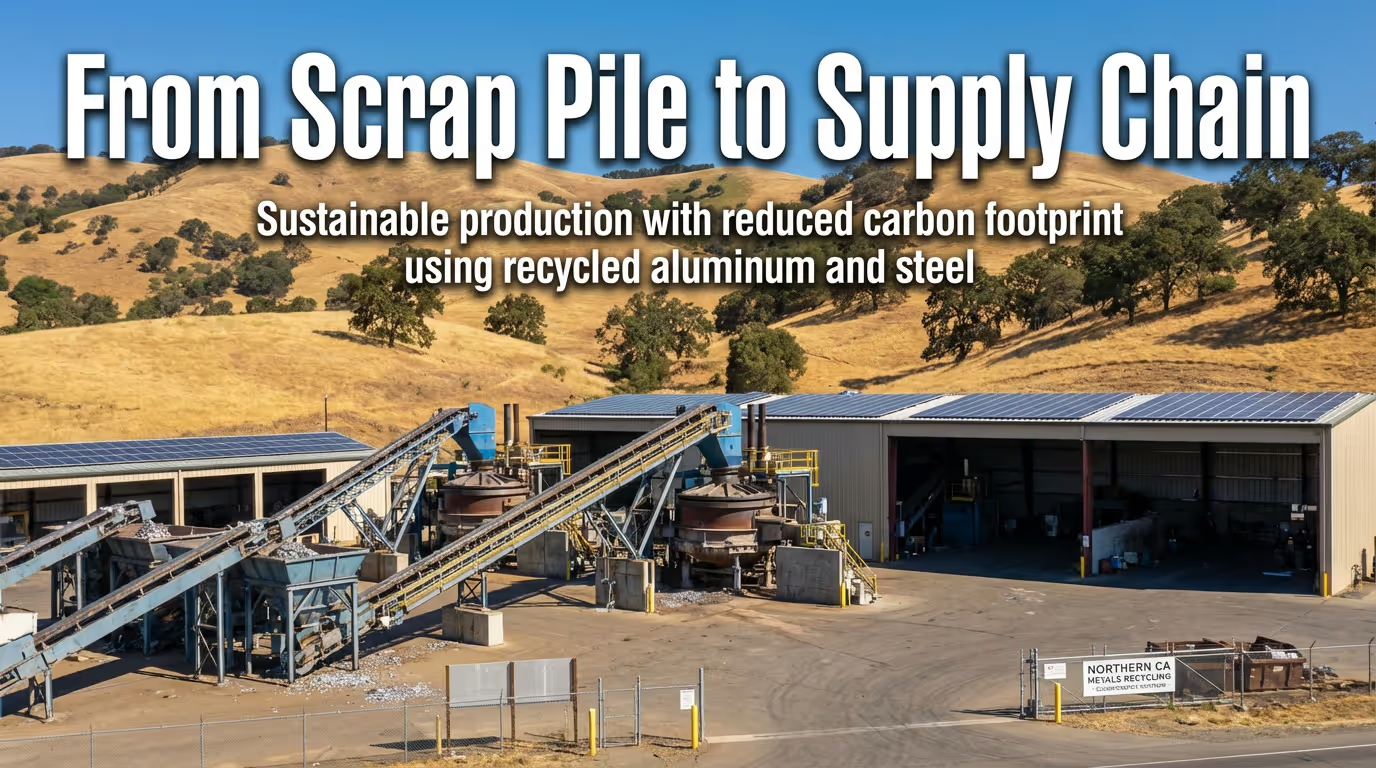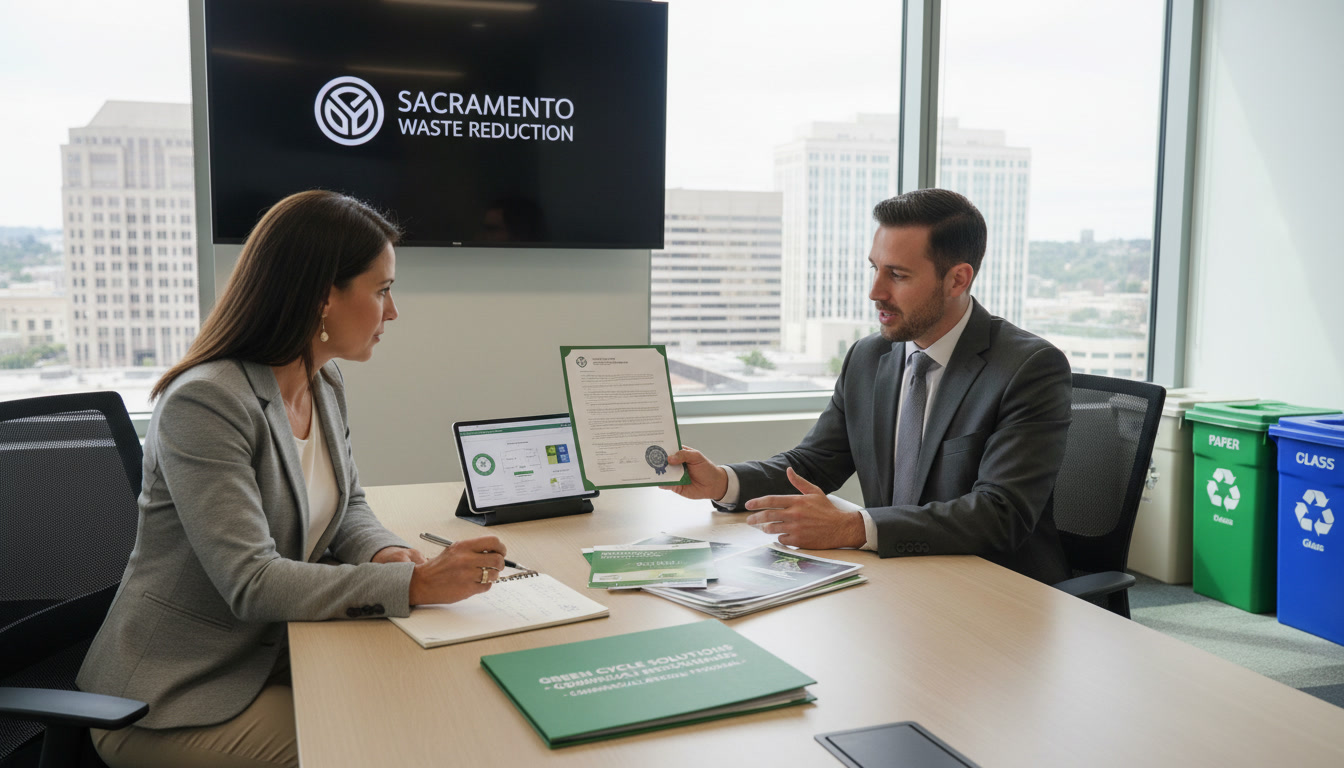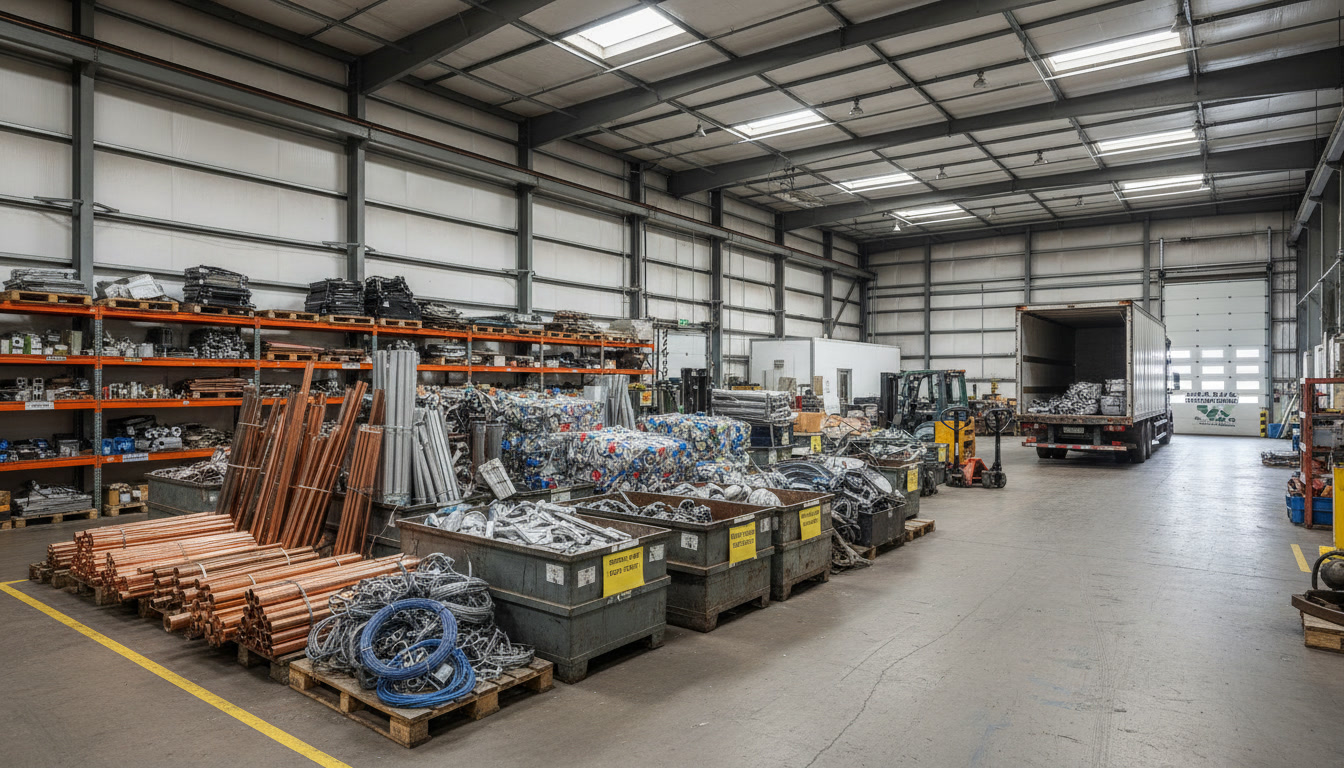Featured Snippet
Getting employees and tenants excited about recycling takes three things: clear signage, simple systems, and ongoing communication. Most programs see 30-50% better participation within three months when you make recycling easy and visible.
Picture this. You install shiny new recycling bins throughout your building. You send an email announcement. Then... nothing changes. Trash cans overflow while recycling bins sit half-empty. Sound familiar?
You're not alone. Most workplace recycling programs start with enthusiasm and end with frustration. The bins are there. The desire is there. But somehow, contamination stays high and participation stays low.
Here's the thing. Successful recycling programs aren't about bins. They're about people. And getting people to change their habits requires strategy, not just equipment.
Why Workplace Recycling Programs Fail
Let's start with the hard truth. Most recycling programs fail for three simple reasons.
Nobody Knows What Goes Where
Stand by your recycling bin for ten minutes. Watch what people throw in. You'll see coffee cups with liquid. Pizza boxes covered in grease. Regular trash mixed with recyclables.
It's not that people don't care. They're confused. Is this plastic recyclable? Does the lid go in? What about the straw?
Without clear answers, people guess. And contaminated recycling often ends up in landfills anyway.
Recycling Is Less Convenient Than Trash
Here's a quick test. Count your trash cans. Now count your recycling bins. In most buildings, trash cans outnumber recycling bins three to one.
When the trash can is right there and the recycling bin is down the hall, convenience wins. Every time.
There's No Accountability or Feedback
Imagine running a sales team without tracking numbers. That's most recycling programs. No metrics. No goals. No updates on progress.
Without measurement and feedback, programs drift. People forget. Habits slide back.
Building a Strategy That Works
Let's fix these problems. Here's your step-by-step plan for a recycling program that actually works.
Step 1: Know Your Starting Point
Before changing anything, measure where you are now.
Walk your building with a clipboard. Document:
How many recycling bins you have and where they're located
Current contamination levels (what doesn't belong in recycling)
Which areas have the most problems
What types of waste your facility generates most
Take photos. Make notes. This baseline helps you measure improvement later.
Survey your people too. Ask them:
Do they know what's recyclable?
Where are the recycling bins?
What stops them from recycling more?
Anonymous surveys get honest answers. And those answers often surprise you.
Step 2: Make Signage Crystal Clear
Good signage is your secret weapon. Not boring posters that people ignore. Clear, visual guides that answer questions instantly.
What Works:
Color-coded bins (blue for recycling, green for compost, black for trash)
Photos of actual items from your workplace
Short lists with checkmarks and X marks
Multi-language options for diverse workforces
Large fonts that are easy to read
Where to Put Signs:
On every single bin
In break rooms and kitchens
Near copiers and printers
In high-traffic hallways
Above disposal stations
Update your signs quarterly. Fresh visuals catch attention better than signs people stopped seeing months ago.
Step 3: Fix Your Bin Placement
Remember that convenience problem? Fix it with the "twin bin" approach.
The Twin Bin Rule: Place a recycling bin next to every trash can. Not down the hall. Not in the next room. Right next to it.
High-Priority Locations:
Break rooms and kitchens
Copy and print areas
Conference rooms
Near elevators
Building entrances
Desk areas
Make recycling as easy as throwing something away. Remove the excuse of inconvenience.
Step 4: Keep Sorting Simple
Complex sorting systems confuse people. Keep it simple with three basic streams:
Stream 1: Mixed Recycling Paper, cardboard, clean plastics, metal cans, glass bottles
Stream 2: Compost/Organics Food waste, paper towels, coffee grounds
Stream 3: Trash Everything else
For buildings that generate special materials like metals or electronics, add clearly marked collection points. But keep the everyday system simple.
Step 5: Train Your People
Email announcements don't work. Real training does. Here's how to do it right.
Monthly 15-Minute Sessions
Schedule quick training sessions during existing meetings. Don't make people attend special sessions. Embed training into their regular schedule.
Monthly Topics:
January: Plastic sorting basics
February: Paper and cardboard
March: Food waste and composting
April: Common contamination mistakes
Keep sessions short. Make them interactive. Bring sample items. Let people practice sorting.
Create Recycling Champions
Recruit volunteers from each department or floor. Give them extra training. Make them your go-to resources.
Champion Responsibilities:
Answer questions from coworkers
Spot contamination problems early
Share tips in team meetings
Report issues to facilities
Rotate champion positions every quarter. This spreads knowledge and keeps people engaged.
Step 6: Use Competition and Recognition
People love friendly competition. Use it to boost participation.
Department Challenges
Track recycling by department or floor. Post monthly standings in common areas. Make it visible.
Prize Ideas:
Catered lunch for winning team
Preferred parking spots
Charitable donation in team's name
Extra break time
Company newsletter feature
Individual Recognition
Spotlight "Recycling Stars" monthly. Recognize people who:
Spot contamination issues
Suggest improvements
Help others learn
Consistently recycle correctly
Recognition doesn't cost much. But it motivates a lot.
Step 7: Communicate Consistently
One announcement doesn't create lasting change. Consistent communication does.
Weekly: Quick tips in company newsletters ("Did you know pizza boxes with grease go in trash, not recycling?")
Monthly: Performance updates with actual numbers ("We recycled 2 tons last month—up 15% from January!")
Quarterly: Impact reports showing environmental benefits ("Our recycling saved enough energy to power 12 homes for a year")
Annually: Comprehensive program reviews with goals for next year
Share both successes and challenges. Transparency builds trust and engagement.
Step 8: Measure and Adjust
Track these key metrics monthly:
Recycling Rate: Percentage of waste diverted from landfills Contamination Rate: Percentage of non-recyclable items in recycling Participation Rate: Survey or observe how many people use bins correctly Cost Savings: Reduced waste disposal fees
Share numbers in relatable terms. Instead of "diverted 10 tons," say "prevented 20,000 pounds of waste from landfills—equal to the weight of 10 cars."
When something isn't working, change it. Run quarterly audits to identify problems. Adjust your strategy based on data, not guesses.
Overcoming Common Obstacles
High Turnover Rate
Include recycling guidelines in onboarding packets. Add information to lease agreements for tenants. Conduct orientation sessions for all new people.
Make recycling part of their first day, not something they figure out later.
Language Barriers
Use pictographic guides that work across languages. Partner with cultural organizations for translation help.
Visual communication often works better than words anyway.
Limited Budget
Start small. Pick one department for a pilot program. Use success data to justify expansion funding.
Even small improvements add up. Prove the concept before scaling up.
Space Constraints
Recycling doesn't require more space. It requires better space use. Replace some trash cans with recycling bins. Use smaller bins placed strategically instead of large bins placed poorly.
Getting Professional Help
Professional recycling partners offer more than just pickup. They provide:
Educational materials customized for your building
Training sessions for employees and tenants
Waste audits to identify opportunities
Program design help
Contamination analysis
Mobile recycling services handle special materials like electronics, scrap metal, and bulk items that standard programs miss. Companies like Willis Recycling serve California businesses with comprehensive solutions.
Professional partners turn recycling from a hassle into a smooth operation.
Making It Stick Long-Term
Initial enthusiasm fades. That's normal. Keep programs strong with these strategies:
Celebrate Milestones: When you hit recycling goals, celebrate publicly. Cake in the break room. Company-wide email. Make achievements visible.
Share Success Stories: Tell specific stories about impact. "Last quarter, our recycling prevented 5 tons of waste from landfills."
Keep Improving: Quarterly audits reveal new opportunities. What's working? What's not? Adjust continuously.
Lead by Example: Management participation matters. When leaders recycle visibly and talk about it, others follow.
Stay Fresh: Rotate signage. Try new incentives. Mix up recognition programs. Novelty maintains attention.
Your 30-Day Action Plan
Ready to start? Here's your first month:
Week 1: Baseline assessment and surveys Week 2: Order bins and create signage Week 3: Install new bins and train champions Week 4: Launch program with kick-off event
Keep momentum going with monthly training and updates. Most programs see measurable improvement within 90 days.
The Bottom Line
Successful recycling programs share common elements. Clear communication. Convenient systems. Consistent follow-through. Recognition and feedback.
The bins alone won't change behavior. But bins plus strategy? That combination works.
Your building can achieve 30-50% participation improvement within three months. Start with one department. Prove the concept. Then expand.
The environment benefits. Your waste costs decrease. And your people feel good about contributing to something meaningful.
That's worth the effort.
Ready to improve your facility's recycling program? Contact Willis Recycling at (916) 271-2691 for professional support with program design, training, and specialized material handling throughout California.
Frequently Asked Questions
How do you motivate employees to recycle at work?
Make recycling convenient by placing bins next to every trash can. Use clear signage with photos showing exactly what goes where. Create friendly competition between departments with visible leaderboards and prizes. Recognize individual "Recycling Stars" in newsletters. Share monthly progress reports showing environmental impact. Most importantly, make recycling as easy as throwing things away—convenience drives participation.
What percentage of employees typically participate in workplace recycling?
Initial workplace recycling participation typically ranges from 20-40% without engagement efforts. With proper training, clear signage, and convenient bin placement, participation can increase to 70-80% within six months. Success depends on consistent communication, strategic infrastructure, and visible leadership support for the program.
How often should you train employees on recycling procedures?
Conduct comprehensive training during onboarding for all new hires. Then provide monthly 15-minute refresher sessions focusing on one specific material type (plastics in January, paper in February, etc.). Run quarterly deep-dives addressing contamination issues and program updates. Hold annual reviews showcasing program impact and environmental benefits to maintain long-term engagement.
What are the biggest barriers to workplace recycling?
The main barriers include confusion about which materials are recyclable, inconvenient bin locations, unclear signage, and lack of accountability. Language barriers, high employee turnover, and limited storage space also challenge programs. Address these through education, improved infrastructure with "twin bins" next to trash cans, visual pictographic guides, and consistent communication with metrics and feedback.
How do you measure recycling program success?
Track four key metrics monthly: recycling rate (percentage diverted from landfill), contamination rate (non-recyclable items in recycling), participation rate (through surveys or observation), and cost savings from reduced disposal fees. Share results in relatable terms like "saved enough energy to power 12 homes" instead of technical measurements. Set specific quarterly goals and celebrate when you achieve them.
Works Cited
[1] Rubicon. "Recycling Contamination Facts." Rubicon.com. https://www.rubicon.com/blog/recycling-contamination-facts/. Accessed October 2025.
[2] Evergreen. "Employee Engagement: Fostering a Recycling Culture in the Workplace." Evergreenwmnm.com. https://www.evergreenwmnm.com/011-employee-engagement-fostering-a-recycling-culture-in-the-workplace. Accessed October 2025.
[3] Berkeley Haas. "America's Broken Recycling System." CMR.berkeley.edu. https://cmr.berkeley.edu/2023/05/america-s-broken-recycling-system/. Accessed October 2025.
[4] Zigpoll. "How Might Individuals' Intrinsic Motivations and Social Influences Impact Their Engagement with a Workplace Recycling Program." Zigpoll.com. https://www.zigpoll.com/content/how-might-individuals'-intrinsic-motivations-and-social-influences-impact-their-engagement-with-a-workplace-recycling-program. Accessed October 2025.
[5] Recycling Partnership. "Best Practices for Community Recycling Programs." RecyclingPartnership.org. https://recyclingpartnership.org/best-practices-for-community-recycling-programs/. Accessed October 2025.



